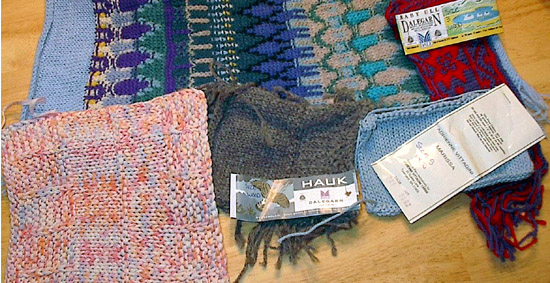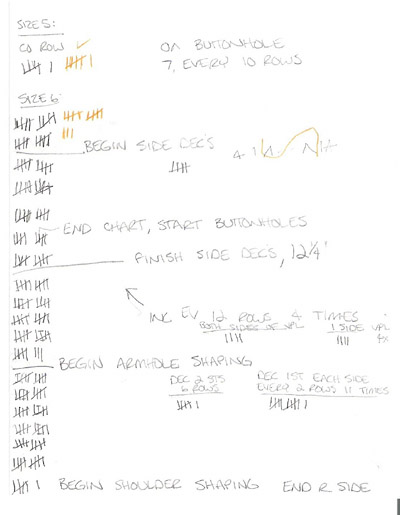| Having
learned to knit all by my lonesome, I never
had anyone to share little short-cuts and interesting
details of knitting with. So, for those of you
like me, here's a list of the stuff I had to
figure out myself. Some of it's obvious, some
of it's not. Most of it, I learned the hard
way. Here's hoping to save you some time and
aggravation.
All these tips are just
that -- tips. Take them to heart or ignore them,
depending on how much use they are to you. I
am also going to share the One and Only Rule
of Knitting: If you are happy with the result
and it doesn't unravel, then it is knit correctly.
- The good thing about smooth
yarns is...they show stitch definition. The
bad thing about smooth yarns is...they show
stitch definition. If you're using one, be
prepared to fix even the most minor detail,
because mistakes will scream out at anyone
looking at the sweater. Split stitches in
particular look horrendous. Fix 'em!
- Bulky yarns mean bulky
sweaters. Average-sized women wearing bulky
sweaters can take on the aspect of a wooly
mammoth, with some bad luck and the wrong
color. You might want to save the bulky stuff
for a coat.
- If you're knitting a gift,
knit what the recipient wants, not what you
want to knit. This may mean committing to
a color you hate, or a style you don't like,
but they'll be thrilled when it's done, and
that's the whole idea. And for heavens' sake,
don't knit a sweater for someone who never
wears them, and be mad when it winds up in
the bottom of a drawer somewhere.
- Watch out for skinny chicks
modeling sweaters in strange, twisty poses.
Usually pattern publishers use those pretzel
poses to keep the sleeves straight, or make
the neck look right, or otherwise hide some
horrible detail about the fit. If there is
a pretzel pose involved, take a second and
third look at the pattern and schematics before
you knit it, and try to identify why the model's
all knotted up.
- There is no law saying
you have to knit the sweater in the same color
as the picture shows, darn it.
- Substituting yarns is
much easier when you stick with the same fiber;
wool for wool, etc. If the whole idea is to
change fibers, keep the weight in mind. For
instance, cotton is much heavier than wool,
yard for yard. Knit a wool pattern with 100%
cotton yarn and it's gonna hang funny. Probably
around your knees.
- If you knit for the fun
of figuring out a pattern (or making one up),
think long and hard about knitting a copy
of anything. It can be boring and go on forever.

You never know when an
old swatch will come in handy,
either to remember what you knit a project with,
or to get some idea of gauge and needle size.
- Keep your yarn swatches,
if you can spare the yarn from your project.
They're a great reference for later on, making
it easy to remember what yarn you used for
what project, and how much you liked it. Make
things really easy, and just staple a ball
band right to the swatch. You can even write
on them with permanent marker.
- Fashion knitting can be
fun, but you need to remember that some extremes
will only be wearable for a season, and if
they took too long to make, or cost too much,
well. It's up to you to decide what's worth
it.
- It's easier to learn three
or four cast-on methods than it is to try
to make one method work, all the time. Same
goes for casting off.
- A gauge swatch knit flat
will often have a different gauge than one
knit in the round, even if you use the same
needles and yarn. Match your swatch knitting
to your sweater plan and save yourself some
grief later.
- Make sure you measure
the swatch STRAIGHT, across one row, not diagonally
across several rows. I did this once. Duh.
- When making a vest or
other sleeveless garment, you HAVE to have
some kind of shoulder shaping, because there
is no sleeve weight to pull the shoulders
down along their natural slope. Without the
sleeve weight, the edges of the armholes wing
up into the air and look kinda...weird. Unless
you have shoulders like a fullback that go
straight across. If that's the case, go for
it.
- Sleeves of two different
lengths are the ultimate cliché in
hand-knitted garments. Avoid it by making
sure you've got the exact same number of rows
in both sleeves. In fact, if you've got the
same number of rows in the font and back,
sewing up is a lot easier, too. But it's not
as vital as the sleeves matching.
-
|
| Yes,
all cats want to help you knit. Really.
She's helping wind that skein into
a ball right now.
See that helpful smile on her face?
|
It isn't vital to
roll skeins of yarn into balls before knitting
them up, but if you (or some other helpful
person) drops it, you've got a heck of a mess
on your hands. It's a risk, but the time saved
can be substantial. Up to you.
- When knitting mittens
and gloves, make sure you make a right and
a left hand. I'm not even going to begin explaining
how I learned that one.
- Unless you really love
finishing (and if so, what is WRONG with you?),
do it a little bit at a time while knitting
your project; darn in ends while taking a
break. You can also put it together as you
knit: do the front and back and join at the
shoulders, then put in each arm as you finish
it, and then you only have the side/underarm
seam to do.
- You can destroy or mutilate
a hundred hours' worth of great knitting with
a half hour of lousy finishing. Take your
time and do it right. If you don't know how
to do it, learn.
- Embroidery floss is great
for sewing things up. It's colorfast, it doesn't
shrink, it's strong and smooth, and it comes
in a kajillion colors. You can double it or
split it to get the weight right.
- Start sewing the side seams
at the hip and sleeve cuff, and meet at the
armpit. If you've got to fudge the sewing
to make the sides match, you don't want it
somewhere it'll show; put the goofy stuff
in the armpit where no one will notice it.
(You hope.)
- Don't knit a beautiful
sweater and then screw it all up by putting
ugly buttons on it. If you can't find the
buttons you want, you can always make them
out of Fimo.
-
 |
| This
is where I kept track of the back of
my latest project. The yellow markings
are where I'm knitting the front, copying
the back. |
Yarn almost always
looks lighter in the skein than it does when
knit. That's because knitted fabric casts
little shadows over the yarn; it's particularly
noticeable in lighter colors.
- If you've got hand
problems, lighter yarns and needles means
less weight for your hands and fingers to
support.
- Cats and knitting
can be an ugly combination. You can scare
the cat off with a squirt gun, if you need
to. Or you can give the cat their own bit
of yarn to play with, or knit it toys and
blankies. Or, you can just give up and let
the blasted cat sleep on the silk throw.
- Row counters are
all well and good, but a pencil and paper
can keep track of multiple things at once,
even where you started the armhole decreasing
or how you did that weird series of increases.
- Instead of spending
dozens of hours dreaming up ways to avoid
using double-point needles to knit in the
round, you could just learn to knit that way.
It's not really that hard.
- Metal knitting needles
-- particularly the larger sizes -- are really
rough on your hands. Try getting something
that flexes slightly with your hands as you
knit. I prefer wood, but they can be slow
to knit with because the wood hangs on to
the yarn; plastic and bamboo are other options.
|

